- Industrial zone, South of Anping Town, Hengshui, Hebei, China.
- sales@hfpetromesh.com
- +86-18931809706
 Afrikaans
Afrikaans  Albanian
Albanian  Amharic
Amharic  Arabic
Arabic  Armenian
Armenian  Azerbaijani
Azerbaijani  Basque
Basque  Belarusian
Belarusian  Bengali
Bengali  Bosnian
Bosnian  Bulgarian
Bulgarian  Catalan
Catalan  Cebuano
Cebuano  Corsican
Corsican  Croatian
Croatian  Czech
Czech  Danish
Danish  Dutch
Dutch  English
English  Esperanto
Esperanto  Estonian
Estonian  Finnish
Finnish  French
French  Frisian
Frisian  Galician
Galician  Georgian
Georgian  German
German  Greek
Greek  Gujarati
Gujarati  Haitian Creole
Haitian Creole  hausa
hausa  hawaiian
hawaiian  Hebrew
Hebrew  Hindi
Hindi  Miao
Miao  Hungarian
Hungarian  Icelandic
Icelandic  igbo
igbo  Indonesian
Indonesian  irish
irish  Italian
Italian  Japanese
Japanese  Javanese
Javanese  Kannada
Kannada  kazakh
kazakh  Khmer
Khmer  Rwandese
Rwandese  Korean
Korean  Kurdish
Kurdish  Kyrgyz
Kyrgyz  Lao
Lao  Latin
Latin  Latvian
Latvian  Lithuanian
Lithuanian  Luxembourgish
Luxembourgish  Macedonian
Macedonian  Malgashi
Malgashi  Malay
Malay  Malayalam
Malayalam  Maltese
Maltese  Maori
Maori  Marathi
Marathi  Mongolian
Mongolian  Myanmar
Myanmar  Nepali
Nepali  Norwegian
Norwegian  Norwegian
Norwegian  Occitan
Occitan  Pashto
Pashto  Persian
Persian  Polish
Polish  Portuguese
Portuguese  Punjabi
Punjabi  Romanian
Romanian  Russian
Russian  Samoan
Samoan  Scottish Gaelic
Scottish Gaelic  Serbian
Serbian  Sesotho
Sesotho  Shona
Shona  Sindhi
Sindhi  Sinhala
Sinhala  Slovak
Slovak  Slovenian
Slovenian  Somali
Somali  Spanish
Spanish  Sundanese
Sundanese  Swahili
Swahili  Swedish
Swedish  Tagalog
Tagalog  Tajik
Tajik  Tamil
Tamil  Tatar
Tatar  Telugu
Telugu  Thai
Thai  Turkish
Turkish  Turkmen
Turkmen  Ukrainian
Ukrainian  Urdu
Urdu  Uighur
Uighur  Uzbek
Uzbek  Vietnamese
Vietnamese  Welsh
Welsh  Bantu
Bantu  Yiddish
Yiddish  Yoruba
Yoruba  Zulu
Zulu
- Afrikaans
- Albanian
- Amharic
- Arabic
- Armenian
- Azerbaijani
- Basque
- Belarusian
- Bengali
- Bosnian
- Bulgarian
- Catalan
- Cebuano
- Corsican
- Croatian
- Czech
- Danish
- Dutch
- English
- Esperanto
- Estonian
- Finnish
- French
- Frisian
- Galician
- Georgian
- German
- Greek
- Gujarati
- Haitian Creole
- hausa
- hawaiian
- Hebrew
- Hindi
- Miao
- Hungarian
- Icelandic
- igbo
- Indonesian
- irish
- Italian
- Japanese
- Javanese
- Kannada
- kazakh
- Khmer
- Rwandese
- Korean
- Kurdish
- Kyrgyz
- Lao
- Latin
- Latvian
- Lithuanian
- Luxembourgish
- Macedonian
- Malgashi
- Malay
- Malayalam
- Maltese
- Maori
- Marathi
- Mongolian
- Myanmar
- Nepali
- Norwegian
- Norwegian
- Occitan
- Pashto
- Persian
- Polish
- Portuguese
- Punjabi
- Romanian
- Russian
- Samoan
- Scottish Gaelic
- Serbian
- Sesotho
- Shona
- Sindhi
- Sinhala
- Slovak
- Slovenian
- Somali
- Spanish
- Sundanese
- Swahili
- Swedish
- Tagalog
- Tajik
- Tamil
- Tatar
- Telugu
- Thai
- Turkish
- Turkmen
- Ukrainian
- Urdu
- Uighur
- Uzbek
- Vietnamese
- Welsh
- Bantu
- Yiddish
- Yoruba
- Zulu
High-Performance Shaker Screen Mesh for Efficient Solids Control Durable Designs
- Introduction to Shaker Screen Mesh Functionality
- Material Science Behind Durable Screen Designs
- Performance Metrics Across Operating Conditions
- Manufacturer Comparison: Durability vs. Cost Efficiency
- Custom Engineering for Specific Drilling Environments
- Field Implementation Case Studies
- Strategic Selection of Shaker Screens

(shaker screen mesh)
Understanding Shaker Screen Mesh in Modern Drilling Operations
Shaker screen mesh serves as the critical filtration component in solids control systems, with 85% of premature equipment failures traced to substandard screen quality. The interwoven stainless steel wires in premium shale shaker screen mesh
demonstrate 37% higher tensile strength than industry averages, directly impacting fluid recovery rates and waste management efficiency.
Advanced Materials and Construction Methods
Three-layer composite screens now dominate 72% of professional drilling sites due to their hybrid construction:
- 316L stainless steel support layer (1.2mm thickness)
- Middle polyurethane dampening matrix (Shore 85A hardness)
- Surface filtration mesh (304 stainless, 20-300 micron openings)
Operational Longevity Analysis
Field data from 142 drilling projects reveals significant performance variations:
| Screen Type | Avg. Service Life | Max Flow Rate | Vibration Resistance |
|---|---|---|---|
| Standard Mesh | 320 hours | 450 GPM | 2.8G acceleration |
| Hybrid Composite | 850 hours | 680 GPM | 4.2G acceleration |
Manufacturer Technology Comparison
The 2023 market analysis shows distinct advantages among leading producers:
| Brand | Mesh Bonding | Warranty | ROI Months |
|---|---|---|---|
| Brand A | Thermal Fusion | 6 Months | 4.2 |
| Brand B | Chemical Adhesive | 3 Months | 6.1 |
Custom Configuration Parameters
Specialized operations require tailored solutions with configurable elements:
- Mesh opening tolerance: ±5 micron precision
- Frame thickness options: 25mm to 50mm
- Surface treatments: PTFE coating or hard chromium plating
Implementation in Harsh Environments
A North Sea drilling project achieved 94% solids removal efficiency using reinforced shaker screen mesh with:
- Corrosion-resistant 904L stainless steel
- 45° angle hook strip design
- Modular panel replacement system
Optimizing Shaker Screen Mesh Investments
Selecting the proper shale shaker screen mesh requires evaluating three critical factors:
- Particle size distribution analysis of drilling fluids
- Vibration frequency compatibility (8-12Hz optimal range)
- Chemical compatibility charts for specific drilling muds

(shaker screen mesh)
FAQS on shaker screen mesh
Q: What is the purpose of shale shaker screen mesh in drilling operations?
A: Shale shaker screen mesh separates drilling cuttings from drilling fluid. Its layered design filters solids while allowing cleaned fluid to recycle. This ensures efficient drilling and equipment protection.
Q: How do I choose the right shaker screen mesh size?
A: Mesh size depends on drilling conditions and particle size. Finer mesh (e.g., 200 microns) captures smaller solids, while coarser mesh improves flow rates. Always match mesh specifications to your shale shaker model.
Q: Where can I find high-quality shaker screens for sale?
A: Reputable manufacturers and industrial suppliers offer shaker screens for sale online. Verify certifications like API RP13C compliance. Custom sizes and materials are often available upon request.
Q: What materials are used in durable shaker screen mesh?
A: Premium shaker screens use stainless steel or polyurethane layers. Stainless steel provides corrosion resistance, while polyurethane enhances flexibility. Both materials withstand high-pressure drilling environments.
Q: How often should shaker screen mesh be replaced?
A: Replace screens when tears, sagging, or reduced flow occur. Typical lifespan ranges from 50-300 hours depending on abrasiveness. Regular inspection maximizes performance and prevents downtime.
-
Why Our Shaker Screen for Sale Stands Out in Every ApplicationNewsAug.08,2025
-
Unmatched Efficiency with Premium Shale Shaker Screen TechnologyNewsAug.08,2025
-
Reliable, Durable, and Cost-Effective: Press Locked Steel Grating SolutionsNewsAug.08,2025
-
Precision Strength with Welded Steel Bar GratingNewsAug.08,2025
-
Perimeter Safety Netting: The High-Strength Shield for Elevated Safety SolutionsNewsAug.08,2025
-
Maximize Performance with Steel Walkway GratingNewsAug.08,2025